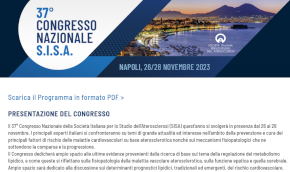 Rivista in lingua italiana
Rivista in lingua italiana
riservata ai Soci SISA
Ultimo numero:
Anno 14 • N.4/2023
SISANews
Lo studio SATURN. I risultati
Già in precedenza era stata dimostrata la possibilità di un effetto positivo delle statine sull'evoluzione dell'aterosclerosi coronarica, che era per lo più limitato al rallentamento della progressione della malattia, anche se in qualche caso si era osservata una vera e propria regressione delle lesioni coronariche. Lo studio SATURN estende queste osservazioni con la dimostrazione che la terapia con dosi massimali di statine (atorvastatina e rosuvastatina) ha ridotto significativamente il volume degli ateromi coronarici, valutati mediante ultrasonografia intravascolare. Il risultato è stato conseguito in pazienti non ipercolesterolemici che hanno ottenuto in ambedue i bracci di trattamento una riduzione del colesterolo LDL al di sotto dei 70 mg/dL. Il livello più basso si è osservato nel gruppo trattato con rosuvastatina 40 mg (62,6±1,0 mg/dL); in quello trattato con atorvastatina 80 mg il livello medio di colesterolo LDL era di 70,2±1,0 mg/dL. Migliore anche il livello di colesterolo HDL nel gruppo rosuvastatina. A fronte di un quadro lipoproteinemico più favorevole nel gruppo rosuvastatina, non si è invece osservato in questo gruppo un effetto più marcato sulla regressione della placca.
![]()
Effect of Two Intensive Statin Regimens on Progression of Coronary Disease
Nicholls SJ, Ballantyne CM, Barter PJ, Chapman MJ, Erbel RM, Libby P, Raichlen JS, Uno K, Borgman M, Wolski K, Nissen SE.
N Engl J Med 2011 Epub Nov 15
Background Statins reduce adverse cardiovascular outcomes and slow the progression of coronary atherosclerosis in proportion to their ability to reduce low-density lipoprotein (LDL) cholesterol. However, few studies have either assessed the ability of intensive statin treatments to achieve disease regression or compared alternative approaches to maximal statin administration. Methods We performed serial intravascular ultrasonography in 1039 patients with coronary disease, at baseline and after 104 weeks of treatment with either atorvastatin, 80 mg daily, or rosuvastatin, 40 mg daily, to compare the effect of these two intensive statin regimens on the progression of coronary atherosclerosis, as well as to assess their safety and side-effect profiles. Results After 104 weeks of therapy, the rosuvastatin group had lower levels of LDL cholesterol than the atorvastatin group (62.6 vs. 70.2 mg per deciliter [1.62 vs. 1.82 mmol per liter], P<0.001), and higher levels of high-density lipoprotein (HDL) cholesterol (50.4 vs. 48.6 mg per deciliter [1.30 vs. 1.26 mmol per liter], P=0.01). The primary efficacy end point, percent atheroma volume (PAV), decreased by 0.99% (95% confidence interval [CI], -1.19 to -0.63) with atorvastatin and by 1.22% (95% CI, -1.52 to -0.90) with rosuvastatin (P=0.17). The effect on the secondary efficacy end point, normalized total atheroma volume (TAV), was more favorable with rosuvastatin than with atorvastatin: -6.39 mm(3) (95% CI, -7.52 to -5.12), as compared with -4.42 mm(3) (95% CI, -5.98 to -3.26) (P=0.01). Both agents induced regression in the majority of patients: 63.2% with atorvastatin and 68.5% with rosuvastatin for PAV (P=0.07) and 64.7% and 71.3%, respectively, for TAV (P=0.02). Both agents had acceptable side-effect profiles, with a low incidence of laboratory abnormalities and cardiovascular events. Conclusions Maximal doses of rosuvastatin and atorvastatin resulted in significant regression of coronary atherosclerosis. Despite the lower level of LDL cholesterol and the higher level of HDL cholesterol achieved with rosuvastatin, a similar degree of regression of PAV was observed in the two treatment groups. (Funded by AstraZeneca Pharmaceuticals; ClinicalTrials.gov number, NCT000620542).

Area Soci
Eventi



 SISA LIPID ACADEMY - Corso avanzato di lipidologia clinica
SISA LIPID ACADEMY - Corso avanzato di lipidologia clinicaModena, 22-23 Giugno 2023
[continua a leggere]Giornale Italiano Arteriosclerosi
HoFH today
 Rivista Italiana della
Rivista Italiana della
Ipercolesterolemia
Familiare Omozigote
Anno 5 • N.1/2023
Rivista NMCD
Diateca
[continua a leggere]
[continua a leggere]
Newsletter
il vostro indirizzo di posta elettronica
Progetto LIPIGEN

Nuovo sito dedicato al Progetto LIPIGEN
Progetto LIPIGEN - Vecchio portale
E' necessario essere loggati come utente
Lipigen per poter accedere alla pagina
PROject Statin Intolerance SISA
PROSISA – PROject Statin Intolerance SISA
E' necessario essere loggati come utente
PROSISA per poter accedere alla pagina
GILA - Lipoprotein Aferesi
Gruppo Interdisciplinare Lipoprotein Aferesi
(Accesso Gruppo GILA-Lipoprotein Aferesi)
E' necessario essere loggati come utente del Gruppo GILA per poter accedere
Gruppo Interdisciplinare Lipoprotein Aferesi
(Documentazione ad accesso libero)
Pagina informativa per medici e pazienti








